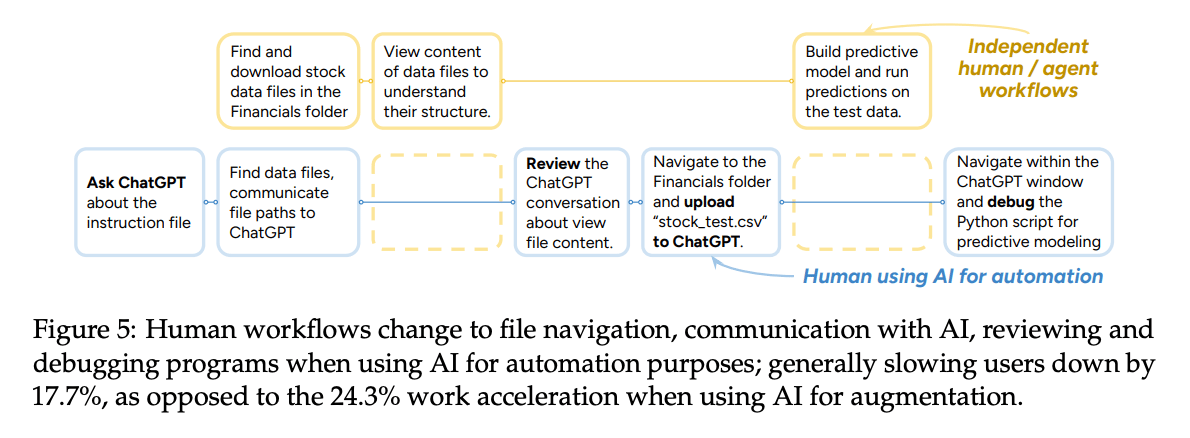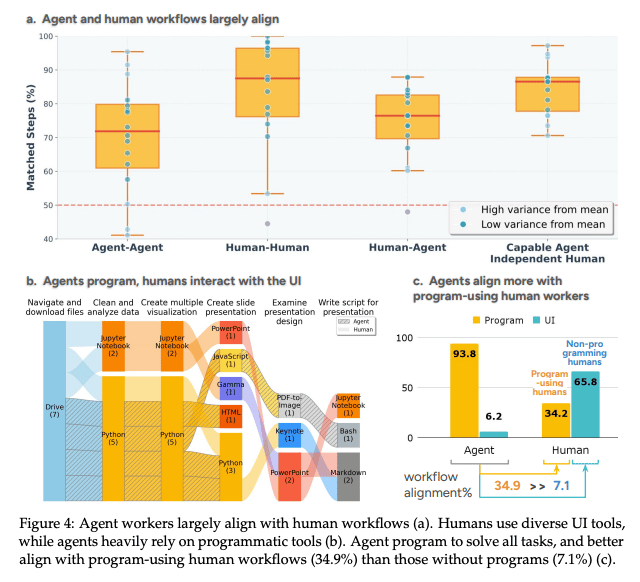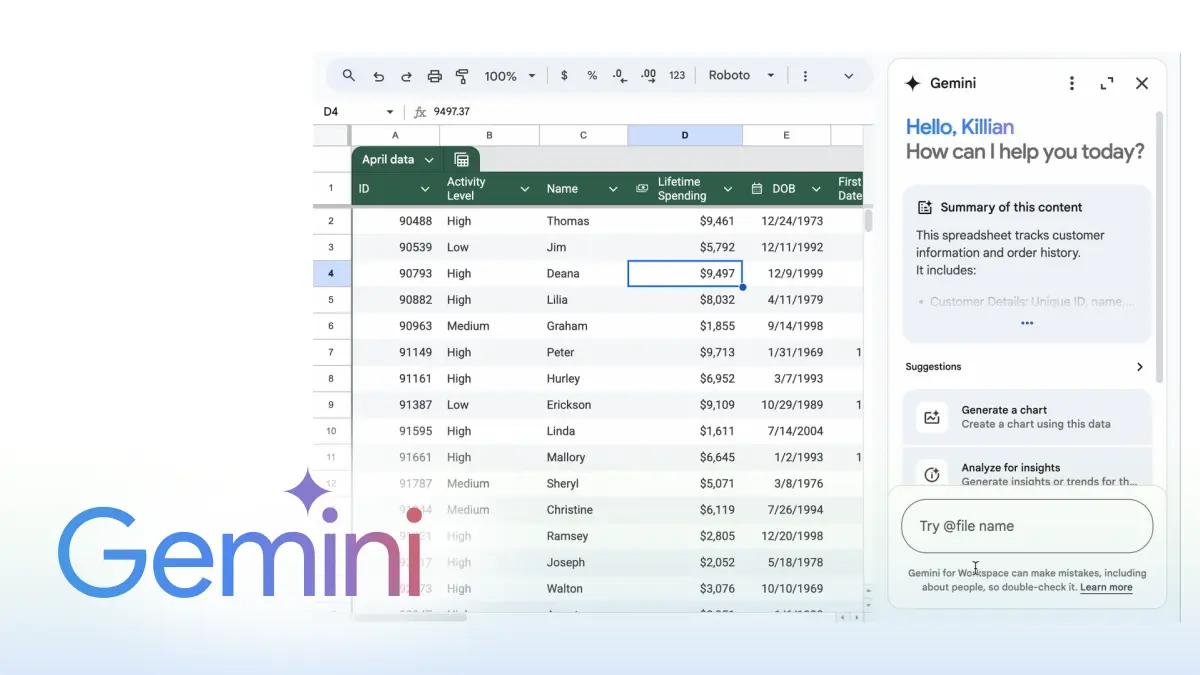
AI Works Best When You Understand Your Workflow
When we help companies bring AI into daily work, the conversation usually starts with the tool. Which model should we use? Can it write emails? Will it save us time?
But time and again, what actually makes or breaks AI success isn’t the tool. It’s the workflow.
That’s what makes the new research from Carnegie Mellon and Stanford: How Do AI Agents Do Human Work? Comparing AI and Human Workflows Across Diverse Occupations is so important. Instead of asking how well AI performs, it asked a more useful question: How does AI actually do the work? What steps does it follow? And how does that compare to what a human would do?
The answers tell a bigger story. It turns out that AI doesn’t just work faster than people. It works differently. And that difference can be powerful or painful, depending on whether your team understands it.
This is why we believe the next wave of AI success won’t come from prompting skills or model upgrades. It will come from workflow literacy, especially at the manager level.
Because if you don’t know how the work happens, you can’t know where AI fits.
AI Support Speeds You Up. Full Automation Slows You Down
The study compared human workers and AI agents on 16 real-world tasks across jobs like finance, engineering, writing, and design. Then it zoomed in on how each completed the work, not just the outcome, but the step-by-step process.
The results were clear. When people used AI for support, helping with a specific step, they got their work done 24.3% faster.
But when they tried to automate the whole process, performance actually dropped. Tasks took 17.7% longer.
Why? Because automation turns humans into supervisors. People spent time checking what the AI did, redoing parts, fixing issues, and trying to understand how it got there. Instead of saving time, they lost it.

The researchers tracked how closely workflows stayed aligned with a typical human process. When AI was used for augmentation, the workflow stayed mostly intact, with 76.8% alignment.
But when AI took over the whole task, alignment dropped to just 40.3%. That’s a sign that things are going off track and no one’s noticing until it’s too late.
This is why many leaders now talk less about automation and more about co-intelligence, where AI extends what we do, without erasing how we do it.
That’s not a limitation. That’s good management.
AI Breaks When Workflows Break
This study didn’t just look at success rates. It went deeper into how work happens, on screen, in tools, step by step. And that’s where the real gap shows up.
Human workers use interfaces like Figma, Excel, and Google Docs. They click, scroll, drag, and build visually. In contrast, AI agents don’t work visually. They code their way through every task, even visual ones.
Across all jobs, even design, AI agents used programming-based workflows 93.8% of the time. For example, instead of adjusting a PowerPoint slide layout like a person would, the agent wrote a Python script to generate the slide content.

This isn’t a bug. It’s a behavior. But it also creates blind spots. In one example, an agent couldn’t read a company report uploaded by the user. So it searched the web for another report, pulled in unrelated data, and built a presentation based on the wrong file. All without saying anything.
That kind of behavior is hard to catch unless managers know how the AI is completing the task. If you only look at the end result, you might not realize it’s based on false or fabricated data.

This is why more teams are starting to run workflow audits, not just output reviews. It’s not about checking what was done. It’s about understanding how it was done.
Managers don’t need to become prompt engineers. But they do need to become workflow literate, able to track how tasks unfold behind the scenes.
You can’t fix what you can’t follow. If you don’t see the steps, you won’t catch the flaws.
And that’s why workflow literacy is an essential skill. It helps managers ask better questions, set clearer expectations, and catch silent failures before they affect outcomes.
The Secret to Speed Is Smart Delegation
One of the most exciting moments in the study came when the researchers paired human workers and AI agents on the same task.
The humans handled the steps that involved navigation, decision-making, or visual judgment. The agents did the parts that involved cleaning data or writing code.
The result? Tasks were completed 68.7% faster.

This kind of hybrid workflow, where each player does what they do best, is where real ROI lives.
One emerging practice is to map workflows by programmability:
- High: Give to AI (for example, spreadsheet cleanup)
- Medium: AI drafts, human verifies (for example, presentation copy)
- Low: Human-led (for example, interpreting client tone or visual branding)
Delegation is not just about what AI can do. It’s about what humans should keep. Leaders have to decide where judgment, emotion, and context belong.
Co-intelligence isn’t about handing over tasks. It’s about sharing momentum. Humans lead with judgment. Agents bring acceleration.
This approach also mirrors what Gartner is now urging executive leaders to consider: leaders must prepare for not one, but four modes of human-AI collaboration. These include:
- AI is filling the gaps where humans are still needed after automation
- AI is running autonomously in parts of the business with little to no human input
- Humans are using AI to get more done in workflows that stay mostly the same
- Humans and AI are transforming work together, unlocking new frontiers of creativity and knowledge
![[Image Alt Text for SEO]](https://cdn.prod.website-files.com/6886eff5344a4d54210f0ea1/6916fb55476487cb13f8f4cd_ai-ripple-effect-helen-it-sym.png)
The solution is to break work into steps, figure out which ones are clearly programmable, and delegate accordingly.
Not every task should be automated. But almost every workflow can be co-piloted.
And that only works if your team understands the structure of work, not just the end goal.
The Bottom Line: Lead Through Workflow
AI success is not about the model you use. It’s about how you design the work.
Here’s what we teach in our Lead with AI Boot Camp when working with teams on adoption:
- Map the workflow: Take real tasks and break them down into steps. Label each one by how clear, repeatable, or programmable it is. This shows you where AI fits and where it doesn’t.
- Train for augmentation, not automation: Encourage your team to use AI tools as assistants for parts of the job. Don’t start by replacing the whole task. Start by sharing the load.
- Delegate by step, not by role: Rethink the handoff. Let the AI agent handle the structured or code-heavy parts. Let people focus on quality, creativity, and judgment.
- Make workflows modular: Restructure work so that it can be picked up, passed on, or recombined. This makes it easier to experiment with human-AI pairing without breaking the process.
- Teach managers how to read workflows: Invest in training managers to understand how work flows through AI systems. Help them spot fabrication, verify quality, and create structure.
You can start by running a workflow-thinking workshop for your leadership team.
The future of work won’t be fully human or fully AI. It will be workflow-aware teams powered by the right kind of support.









